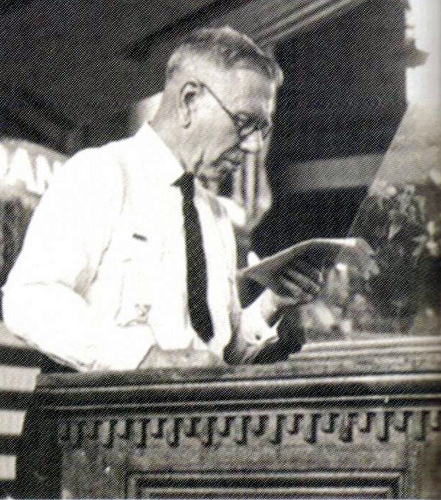By M. A. Tomlinson, former General Overseer. 72nd Annual Address, 1977
It is a matter for concern today that there are some in the Church, by covenant, who do not accept the truth that they are in the One Church of the Bible. One time the Lord spoke to the prophet Ezekiel concerning Israel’s lack or loss of vision. They were in captivity at the time. They had forsaken theocracy and were no longer “The church in the Wilderness,” but God never ceased reminding them of His will. Ezekiel says: “And he said unto me, Son of man, the place of my throne, and the place of the soles of my feet, where I will dwell in the midst of the children of Israel for ever, and my holy name, shall the house of Israel no more defile…” (Ezek. 43:7).
Then the Lord mentioned some of Israel’s defilements, saying that they would have to put those things away before He would dwell in their midst. Then notice verses 10 and 11: “Thou son of man, shew the house to the house of Israel, that they may be ashamed of their iniquities: and let them measure the pattern. And if they be ashamed of all that they have done, shew them the form of the house, and the fashion thereof….”
In His foreknowledge, God knew what Israel would do; therefore, it is possible that His words carried more meaning for the Church that would be established by His Son, since the Church would be His dwelling place forever, and must be without spot or wrinkle, holy and without blemish.
It is true that some in the Church do not see it as the prophetic house of God. In all fairness and love, we should do our best to show them the house, or the Church. Then, if they will acknowledge the Scriptural vision, and the necessity of accepting and obeying the Word of God in its entirety, perhaps we can go on and show them the particulars of the Church’s government and operation in accordance with the Scriptures.
If they are to remain in the Church, they should be helped to understand that not only are they Children of God by the new birth, but that the sacred covenant they took in the presence of God and the witnesses present made them
members of the Body of Christ. If they can see the Church as that one body, they will be glad to measure the pattern. I am afraid that the Church is not being preached and taught as generally and as thoroughly as it once was. Possibly some think that this will turn people away. Although some may turn away because we seem too churchy, what about the many others who are earnestly searching for the one Church? Those who turn away are just not ready to accept the whole Bible as the Word of God; but others are ready, and we must not fail to give them the truth. This is our distinctive responsibility. Nobody else is going to preach this, for it is not given them to preach.
It is almost impossible for new members and young people to see the Church unless we show it to them from the Scriptures. The divine revelation has the Word of God as its authority. Operating the organizational part, without preaching the Church as the divine organism or body, could be more blinding than revealing. We cannot afford to withhold any part of the full vision of the pillar and ground of the truth. We have to see the house ourselves before we can preach it clearly to others.
Just as there was only one Christ of prophecy, so is there just one Church of Prophecy. Jesus proved Himself to be Christ by His perfect fulfillment of all things written of Him in the volume of the Book. Many failed to recognize Him because they were so steeped in Jewish tradition, but Jesus came to reveal the Father’s perfect will and to set it in motion…
If the Church is not being preached and taught according to the divine revelation, somewhere along the line we will have to do much of our work over. It is much easier to be thorough as we go along…
It was a visible church that Jesus set in order when He called unto Him whom He would, ordained the ministry, gave them their commission, had a record made, and sent them forth (Mark 3:13-19). It was a visible church that walked with Him from then until His ascension. It was a visible church that was endued with power on the Day of Pentecost; and it was a visible church that “went forth, and preached every where, the Lord working with them, and confirming the word with signs following” (Mark 16:20)…
The theory of an invisible Church developed during the Dark Ages as a result of the confusion of denominationalism. Zealous groups received individual rays of light and began to build up organizations on isolated doctrines. They knew that they were not the Church they read about in the Bible, so they concluded that the Biblical Church was invisible, or a spiritual church, the membership of which was known only in heaven. Eventually they became so steeped in the denominational theory that they refused to break with tradition when the due time arrived. Just as the Jews had done when the Church was first established by Jesus.
But the Church had to arise from its covering of creeds and erroneous teachings that had been heaped upon it through 1,578 years of the Dark Age Period… When the Church arose in fulfillment of prophecy on June 13, 1903, it was a visible body which began functioning under the principle of theocratic government just as in the early days…
I feel I must repeat that if the Church is not being preached and taught from the viewpoint of prophecy and the New Testament pattern, we will have more and more people who will not understand our reason for operating as we do. It is very important that the truth of one Church for all, functioning just as it did from the time of its establishment by Jesus until the time of the apostasy, be taught and preached without the slightest compromise of deviation. It is not a matter of being either like or different from the commonly accepted practices among Christian groups. Our concern is to follow the early Church pattern, which God set forth in the law and the prophets…
It is evident that we are going to have to prove the identity of the Church by Scriptural authority, no matter how much its uniqueness clashes with the accepted religious systems of our day.


